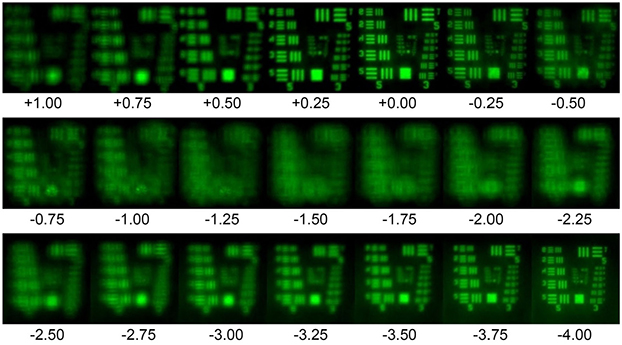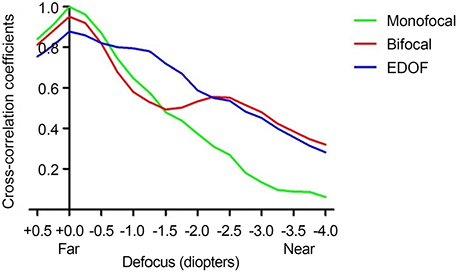J Korean Ophthalmol Soc.
2020 Feb;61(2):153-158. 10.3341/jkos.2020.61.2.153.
Measuring Defocus Curves of Monofocal, Multifocal and Extended Depth-of-focus Intraocular Lenses Using Optical Bench Test
- Affiliations
-
- 1Department of Ophthalmology, Chuncheon Sacred Heart Hospital, Hallym University College of Medicine, Chuncheon, Korea.
- 2Department of Electronic Engineering, College of Engineering, The University of Suwon, Hwaseong, Korea.
- 3Department of Ophthalmology, Bucheon St. Mary's Hospital, College of Medicine, The Catholic University of Korea, Bucheon, Korea.
- 4Department of Ophthalmology, Seoul St. Mary's Hospital, College of Medicine, The Catholic University of Korea, Seoul, Korea.
- 5Department of Ophthalmology, Yeouido St. Mary's Hospital, College of Medicine, The Catholic University of Korea, Seoul, Korea. huanghs@hanmail.net
- KMID: 2470737
- DOI: http://doi.org/10.3341/jkos.2020.61.2.153
Abstract
- PURPOSE
To determine the through-focus optical bench test performance of monofocal, bifocal, and extended depth-of-focus intraocular lenses (IOLs), and to measure their defocus curves.
METHODS
A model eye was placed on an optical bench to test three different IOLs (TECNIS ZXR00, ZMB00, and ZCB00; Abbott Medical Optics, Santa Ana, CA, USA). The focus was changed by inserting trial lenses from +1.00 diopters to −4.00 diopters, in increments of +0.25 diopters. The 1951 United States Air Force Resolution chart was used to determine the quality of the images. The degree of similarity with reference images was given by the cross-correlation coefficient, and defocus curves were drawn and compared.
RESULTS
Bifocal IOLs showed lower image quality with the addition of minus diopter trial lenses, but showed good image quality at near distance. Bifocal IOLs also showed a "˜double peak' in their defocus curve. Monofocal IOLs showed a lower image quality and cross-correlation coefficient with addition of lower-diopter trial lenses. The extended depth of focus IOLs showed a single peak in their defocus curve, but had a wider range of diopters and better image quality than monofocal IOLs.
CONCLUSIONS
Bifocal IOLs showed a double peak defocus curve, and extended depth of focus IOLs showed a wider diopter range and better image quality than monofocal IOLs.
MeSH Terms
Figure
Reference
-
1. Maxwell WA, Cionni RJ, Lehmann RP, Modi SS. Functional outcomes after bilateral implantation of apodized diffractive aspheric acrylic intraocular lenses with a +3.0 or +4.0 diopter addition power Randomized multicenter clinical study. J Cataract Refract Surg. 2009; 35:2054–2056.2. de Vries NE, Webers CA, Touwslager WR, et al. Dissatisfaction after implantation of multifocal intraocular lenses. J Cataract Refract Surg. 2011; 37:859–865.
Article3. Weeber HA, Meijer ST, Piers PA. Extending the range of vision using diffractive intraocular lens technology. J Cataract Refract Surg. 2015; 41:2746–2754.
Article4. Kohnen T, Böhm M, Hemkeppler E, et al. Visual performance of an extended depth of focus intraocular lens for treatment selection. Eye (Lond). 2019; 33:1556–1563.
Article5. Cochener B. Concerto Study Group. Clinical outcomes of a new extended range of vision intraocular lens: International Multicenter Concerto Study. J Cataract Refract Surg. 2016; 42:1268–1275.
Article6. Attia MSA, Auffarth GU, Kretz FTA, et al. Clinical evaluation of an extended depth of focus intraocular lens with the salzburg reading desk. J Refract Surg. 2017; 33:664–669.
Article7. Kim MJ, Zheleznyak L, Macrae S, et al. Objective evaluation of through-focus optical performance of presbyopia-correcting intraocular lenses using an optical bench system. J Cataract Refract Surg. 2011; 37:1305–1312.
Article8. Hwang HS, Lee CS. Analysis of autofocusing evaluation functions of intraocular lens. J Inst Contr Robot Syst. 2017; 23:758–763.9. Carson D, Hill WE, Hong X, Karakelle M. Optical bench performance of AcrySof((R)) IQ ReSTOR((R)), AT LISA((R)) tri, and FineVision((R)) intraocular lenses. Clin Ophthalmol. 2014; 8:2105–2113.10. Gatinel D, Houbrechts Y. Comparison of bifocal and trifocal diffractive and refractive intraocular lenses using an optical bench. J Cataract Refract Surg. 2013; 39:1093–1099.
Article11. Montés-Micó R, Madrid-Costa D, Ruiz-Alcocer J, et al. In vitro optical quality differences between multifocal apodized diffractive intraocular lenses. J Cataract Refract Surg. 2013; 39:928–936.
Article12. Yoo YS, Whang WJ, Byun YS, et al. Through-focus optical bench performance of extended depth-of-focus and bifocal intraocular lenses compared to a monofocal lens. J Refract Surg. 2018; 34:236–243.
Article13. Plaza-Puche AB, Alió JL, MacRae S, et al. Correlating optical bench performance with clinical defocus curves in varifocal and trifocal intraocular lenses. J Refract Surg. 2015; 31:300–307.
Article14. Ruiz-Mesa R, Abengózar-Vela A, Aramburu A, Ruiz-Santos M. Comparison of visual outcomes after bilateral implantation of extended range of vision and trifocal intraocular lenses. Eur J Ophthalmol. 2017; 27:460–465.
Article15. Kaymak H, Hohn F, Breyer DR, et al. Functional results 3 months after implantation of an “extended range of vision” intraocular lens. Klin Monbl Augenheilkd. 2016; 233:923–927.16. Pedrotti E, Bruni E, Bonacci E, et al. Comparative analysis of the clinical outcomes with a monofocal and an extended range of vision intraocular lens. J Refract Surg. 2016; 32:436–442.
Article17. Gatinel D, Loicq J. Clinically relevant optical properties of bifocal, trifocal and extended depth of focus intraocular lenses. J Refract Surg. 2016; 32:273–280.
Article
- Full Text Links
- Actions
-
Cited
- CITED
-
- Close
- Share
- Similar articles
-
- Clinical outcomes of currently available multifocal intraocular lenses
- Comparison of Optical Aberrations and Contrast Sensitivity between Monofocal and Multifocal Intraocular Lens
- Visual and Refractive Outcomes of Diffractive Trifocal Versus Hybrid Multifocal-extended Depth of Focus Intraocular Lenses
- Comparison of Wavefront Analysis and Visual Function Between Monofocal and Multifocal Aspheric Intraocular Lenses
- The change of visual acuity and visual field by diminished illumination in eyes with multifocal intraocular lens






